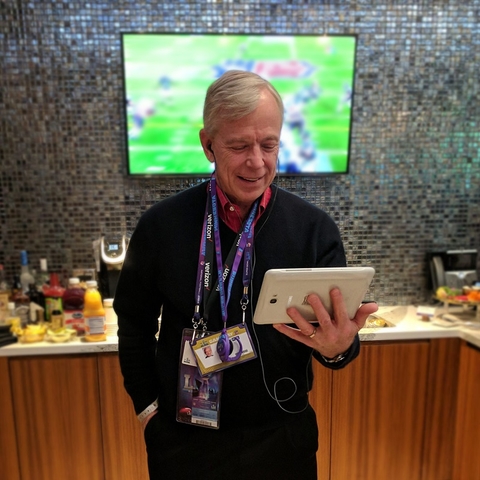Justin Timberlake wasn’t kidding around when he teased fans about the Super Bowl selfie. Football fans lit up the networks of all the nationwide carriers during the week leading up to the show and went into overdrive during the actual event, using more than 7.2 terabytes (TB) of data in and around the stadium on AT&T’s network alone during the big game—a figure that’s equal to more than 20.6 million selfies from the stands.
Wireless operators have gotten pretty good at preparing for the Super Bowl, bringing in Cells on Wheels (COWs) and making sure generators are in position, but they’re also making permanent changes. AT&T enhanced or built 122 new permanent cell sites near heavily trafficked places like hotels, airports and convention centers in Minneapolis.
Sprint deployed its special Magic Box small cell in hundreds of locations across Minneapolis-St. Paul, in addition to upgrading hundreds of cell sites in the market to include all three of its spectrum bands: 800 MHz, 1.9 GHz and 2.5 GHz. Like AT&T, it also benefited from distributed antenna system upgrades.
The event also reinforced the speed proclamations that carriers are making. T-Mobile reported that its 35x capacity increase in Minneapolis paid off, with T-Mobile customers clocking the fastest upload and download speeds at U.S. Bank Stadium according to Speedtest data from Ookla. T-Mobile said its speeds were 2.2x faster than Verizon's.
T-Mobile also released some additional tidbits: Tom Brady’s fumble and the Eagles’ field goal were the most shared moments of the game on social, with a 33% increase in posts. Social posts doubled during Timberlake’s halftime show versus the rest of the game, and nationwide, group and picture messaging went up by nearly 50%, with texting increasing nearly 10%.
But according to Verizon, its customers benefited from the highest average download speeds at the stadium, citing third-party testing by P3 of all four national carriers during the game.
Verizon also said its network was used by 57% of the attendees in the stadium at this year’s Super Bowl, up from 45% the previous year, and said its fans used 18.8 TB of data in and around the stadium, which is equivalent to a single user binge-watching HD video for 435 straight days.
The top three favorite social media apps of Verizon customers were Snapchat, Facebook and Instagram, with Snapchat moving from third at last year’s Super Bowl to first most used this year.
Verizon also used the Super Bowl as the backdrop for a quiet 5G proving ground, which suggests Samsung may be closer to having an end-user device than previously thought. Verizon CEO and Chairman Lowell McAdam and Korea Telecom (KT) CEO Chang-Gyu Hwang conducted a live video call between Minneapolis and Seoul, Korea, using prototype 5G tablets.

In addition, Verizon streamed 180-degree stereoscopic video from the stadium in Minneapolis to virtual reality headsets in New York City to show live action on the field; they also showed high-resolution replays on secondary screens using 5G technology.
For its part, Samsung supplied network infrastructure composed of 28 GHz access units, 5G home routers (CPEs), virtualized RAN and virtualized core network, as well as the prototype 5G device. Samsung said it has leveraged in-house technology and assets to develop the first commercial ASIC-based 5G modems and mmWave RFICs, and with these technical advancements, it has been able to bring one of the smallest 5G radio base stations and CPEs to market.
Verizon, KT and Samsung have been working closely on 5G research and development since 2015, including in Verizon’s 5G Technical Forum and KT’s PyeongChang 5G Special Interest Group, which collectively released early 5G specifications to foster the 5G ecosystem.
And if nothing else, the game reinforced the intense rivalry in wireless. While it might have seemed to come out of nowhere—after all, AT&T won the contract with FirstNet to deliver the nation’s first LTE network dedicated to public safety—Verizon enlisted Timberlake to do a voice-over asking viewers to share their appreciation to first responders in their local communities. Verizon said it was its first in-game Super Bowl ad since 2011.

